What You Will Learn in This Article
- What is an Elimination Diet?
- My discovery and experience with an Elimination Diet
- Why are we suddenly so sensitive to foods?
- Top 10 benefits of following an Elimination Diet
- Which foods to eliminate
- Helpful tools when you’re doing an Elimination Diet
- After the Elimination Diet: How to reintroduce foods
- FAQ: Why start with food?
- FAQ: Why not just do an allergy test like IgG?
- What’s next? Life after reintroduction
- Conclusion
You may have heard me speak—or you have read—about the Elimination Diet many times before. I do it for a reason: it is one of the most overlooked and underrated medicinal tools that will not only balance your hormones but relieve you of many other symptoms, some that might have plagued you for years.
I hope this comprehensive article helps you appreciate the power of the Elimination Diet and motivates you to try it. It might change your life.
What Is An Elimination Diet?
An elimination diet is a temporarily restricted diet that is meant to lower inflammation and the overall toxic load on the body.
This allows the body to put all its efforts toward healing, whether that’s healing the gut, detoxing the liver, repairing damage to the thyroid, or balancing hormone production.
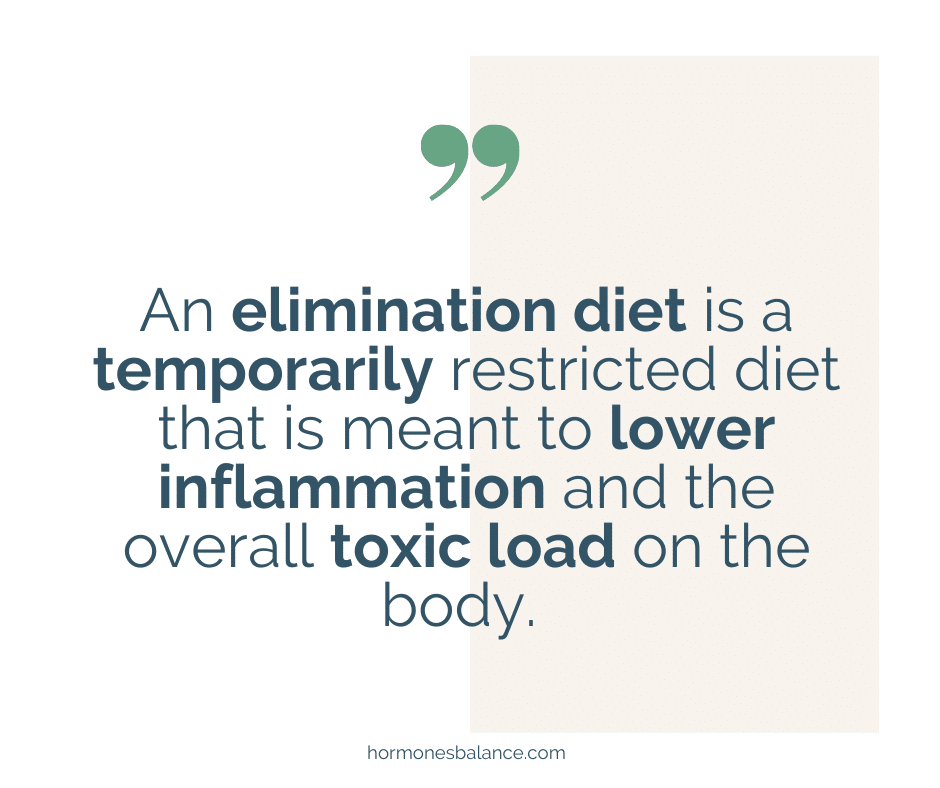
I’m a big believer in the fact that the body is innately designed to heal itself. By eliminating a lot of the inflammatory substances and lightening the toxic load on the body, we’re creating that perfect environment for the body to heal itself much faster, and that includes achieving hormonal balance.
This is a practice not only used for hormonal balance, but also for pretty much any other symptoms, which you’ll see listed below.
My Discovery of The Elimination Diet
My discovery of the elimination diet goes back to my late twenties. At that time, I was dealing with horrible cystic acne that covered my face, butt, back, and chest. I was absolutely covered in it.
I was asked to be Maid of Honor at my friend’s wedding and she had designed the bridesmaid dresses herself. The problem was – it was open-front and open-back.
I said to her, “There’s no way I’m going to wear this!” At that point, I didn’t own a single piece of clothing that was open at the back like that — just because of my pimples.
Along with the cystic acne, I had a lot of other symptoms:
- Really dry skin
- Migraines
- Terrible PMS
- Chronic constipation
- Brain fog, slump, and fatigue, especially after meals
- Extreme bloating — I looked like I was 3 to 4 months pregnant even though I was in my 20s and was super fit and slim.
Those were some of my issues. Around that time, I came across the idea that food could make an impact on skin. I read an article on how scientists had found a connection between bread and acne. Keep in mind, this was around 25 years ago, in the late 1990s.
I found that intriguing, so I decided to cut out gluten for a while and half of my pimples disappeared. I followed up with a food sensitivity test and found out that I also had problems with dairy and eggs.
As it turned out, eggs were the second contributor to my cystic acne (in addition to gluten) and dairy was the cause behind my constipation. In removing these foods, my migraines also went away, as did my bloating, brain fog after meals, and chronic fatigue.
By removing these three foods, I made a huge difference in my symptoms. As a result, I became an instant believer in the connection between food and seemingly random health issues.
It was fascinating that I was doing this elimination diet to get rid of pimples, but so many other aspects of my health immediately improved, too.
Why Are We Suddenly So Sensitive To Foods?
You might wonder why so many people have food sensitivities now when things like gluten and dairy never seemed to be an issue for our parents or grandparents. In the past, everyone seemed to do just fine eating wheat, milk, and eggs just about every day of the week. No one had restrictions.
One of the reasons for this is that our foods aren’t what they used to be. There have been a lot of changes in the way we grow foods (including pesticides, herbicides, and chemical fertilizers) and in how the food is processed after being harvested.
For example, bread in the past was made:
- With non-hybridized grains that had lower gluten levels
- With grains that had been soaked and fermented (as a sourdough bread) to break down a lot of the antinutrients like lectins, gluten, gliadin, etc.
- Without added dough conditioners, synthetic nutrients, and other additives.
Now, about 90% of the population eats a highly processed version of bread rather than the organically raised, 100% heirloom grains that have been long-fermented using traditional cultures and methods.
Additionally, our bodies are dealing with a lot more now than they had to in the past. As women in the workforce, we experience a lot more stress than we would have as traditional homemakers. There are also a lot more environmental toxins surrounding us.
All of these things impact our GI health, which then impacts our immune and endocrine (hormonal) systems and how reactive we are to things in our internal and external environments.
Top 10 Benefits of An Elimination Diet
The great thing about doing an elimination diet is that it can address a lot of symptoms at once. You don’t necessarily need to track down each and every physical symptom with a different approach.
For example, you might have a list of symptoms like itchy ears, PMS, migraines, digestive symptoms, pimples… and the list goes on.
Chasing down different solutions and types of practitioners to address each of those symptoms (allergist, endocrinologist, GI doctor, esthetician) can drive a person crazy and drain the bank account with consults, medications, supplements, skincare products, and different herbs.
What I’ve found fascinating about the elimination diet is that, as a practitioner, someone may come to me with 20 different symptoms. I put them on the elimination diet, and that might take care of 15 of them, including issues they have struggled with for years and years and could not resolve.
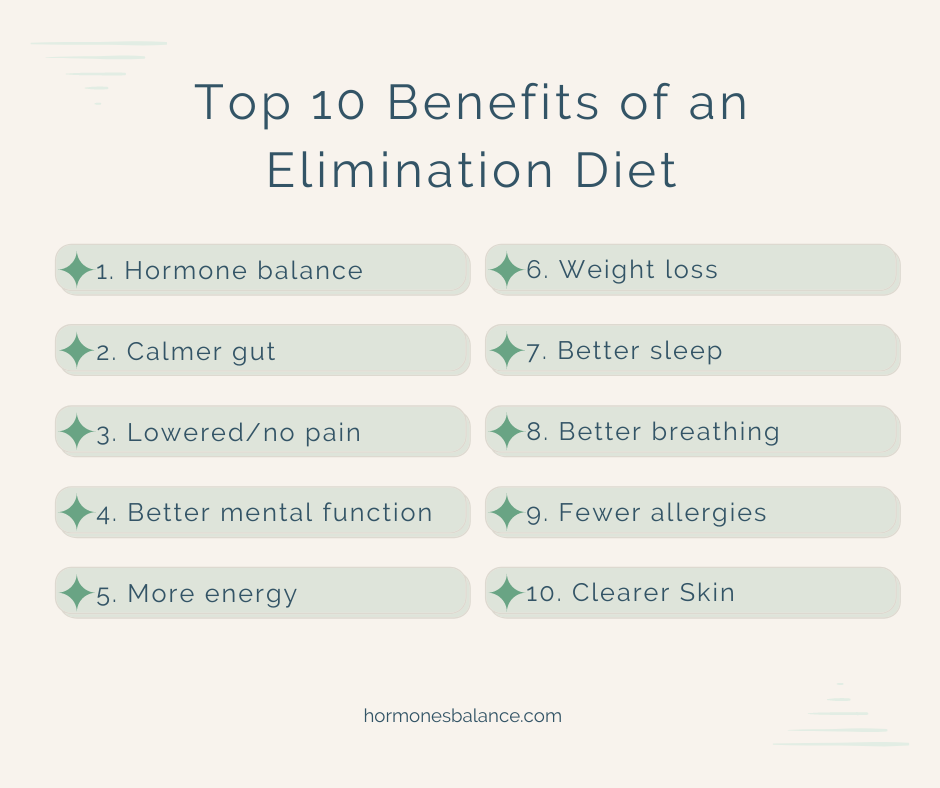
Here are some top overall health benefits many women experience after going on an elimination diet:
#1 Hormone Balance
Following an elimination diet for a period of time may get you back to hormonal balance, with the elimination or reduction of:
PMS symptoms, including bloating and mood swings
- Hot flashes
- Irregular or no periods
- Adrenal fatigue
Let’s go a little more in-depth on how an elimination diet helps promote hormone balance.
#2 Calmer Gut
Lowering overall inflammation and toxicity can lead to a calmer gut. By “calmer,” I mean:
- Elimination or reduction of IBS symptoms like gas, bloating, acid reflux, constipation, diarrhea, stomach pain, and cramping
- Improvement or total healing of autoimmune conditions (I credit the elimination diet the reason my Hashimoto’s antibodies went down a lot)
- Improved microbiome balance
- Fewer gut infections like candida, SIBO, or parasites
A randomized controlled trial of an elimination diet on those with IBS found that 12 weeks of following the diet based on individualized testing was helpful in lowering symptoms. (1)
#3 Lowered Pain or No Pain
As inflammation goes down, we tend to experience less pain. You may have an elimination or reduction of:
- Headaches and migraines
- Chronic muscle or joint pain
- Back pain
- Arthritis
- Carpal tunnel pain
A 2020 review study published in the journal Headache found that elimination diets helped decrease the frequency of migraine attacks. (2)
#4 Better Mental Function
The gut and brain are strongly connected. When the inflammation is lower and the gut has calmed down, there’s often elimination or reduction of:
- Anxiety
- Depression
- Brain fog
- Difficulty concentrating
- Memory issues
#5 More Energy
Lowering the burden of inflammation and toxicity in the body, you may find that:
- It’s easier to get up in the morning
- You feel rested after a night of sleep
- Not as much sleep is needed
- You are less reliant on coffee and other stimulants
Read more on this topic in my articles 11 Ways Coffee Impacts Your Hormones And How to Find a Substitute and How to Fix Your Sleep After 45.
#6 Weight Loss
An elimination diet is often helpful for supporting weight loss. That may happen with improved gut and liver health, restoring a normal metabolism, and improving your energy so you feel like being active. You may find that:
- Stubborn weight starts going away
- Belly fat goes down or completely goes away
- Weight loss is more stable and doesn’t yo-yo so much
- Water retention goes away (puffy hands and legs slim down)
#7 Better Sleep
In general, people tend to experience better sleep, after an elimination diet. That includes:
- An improved ability to fall asleep
- Deeper and higher-quality sleep
- Waking up rested in the morning (!!!)
- Less reliance (or even no reliance) on sleeping pills and supplements
#8 Better Breathing
By lowering inflammation, an elimination diet promotes better breathing, with the elimination or reduction of:
- Stuffy nose
- Asthma
- Sinus infections
- Sleep apnea in some people
#9 Fewer Allergies
Those dealing with allergies of various kinds may find that they aren’t as bad or are totally eliminated. This includes:
- Seasonal allergies (Hay Fever)
- Chronic allergies (such as to cats and dogs)
#10 Clearer Skin
Getting the body cleaned out and avoiding allergens can create clearer skin. It can lead to the elimination or reduction of:
- Acne
- Eczema or psoriasis
- Rosacea
- Rashes
- Hives
A 2018 review study published in Skin Therapy Letter confirmed elimination diets as a way to treat a variety of skin diseases, including those listed above as well as aging skin. (3)
The Elimination Diet For Women: How The Elimination Diet Can Help Balance Your Hormones
There are many routes by which an elimination diet can help balance your hormones. These involve lowering inflammation, improving gut and liver health, lowering toxicity, and improving the immune response.
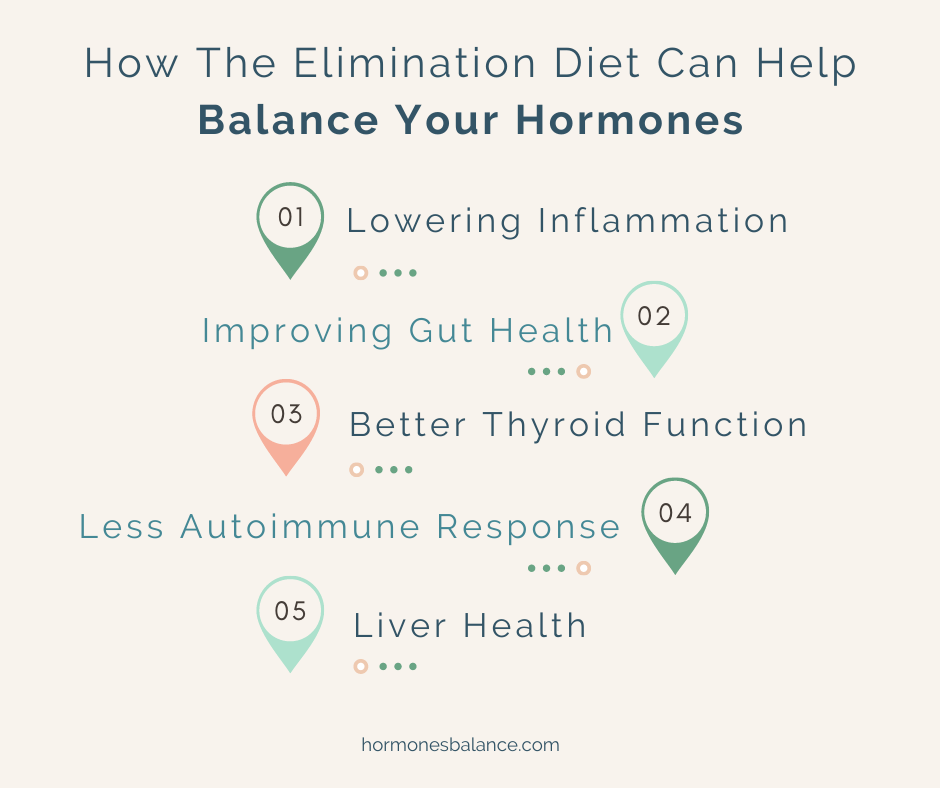
Here’s a quick summary of each of these areas:
Lowering Inflammation
As inflammation goes down during an elimination diet, hormone receptors are more open, allowing hormones to do their work.
Improving Gut Health
As gut health is improved, with better bowel movements, used-up hormones are less likely to be recirculated, leading to estrogen dominance. Dairy is a good example, as it tends to cause constipation in women. Clean and dirty estrogens are produced in the gut because of the estrobolome (estrogen-metabolizing bacteria) that live there.
Read How Your Digestion Impacts Hormone Imbalance and Weight Gain.
Better Thyroid Function
As toxicity goes down, the thyroid functions better and there’s improved conversion of T4 to the active T3.
Less Autoimmune Response
Lowering inflammation and healing the gut also tends to lower autoimmunity. So, any conditions related to the autoimmune response may improve.
Liver Health
As inflammation and toxicity are reduced, the burden on the liver is lessened. The liver plays a huge role in our hormone balance. Learn more about that in this article on the liver.
Which Foods Are To Be Excluded?
There are different variations of the elimination diet. For example, some eliminate all grains, others take out beef, some eliminate nuts, etc. I leave those in because I haven’t found people to be that reactive to those, unless you need to go deeper with another therapeutic diet.
We focus on practicality and the research that’s behind it, so below are the foods we recommend excluding on a basic elimination diet. It’s just 7 categories… and it’s just temporary.
- Gluten (wheat, spelt, barley, and rye)
- Dairy (including milk from cow, goat, and sheep)
- Soy (including miso, edamame, tempeh, soy sauce, etc)
- Corn (keep in mind things like dextrose, and other additives which may be derived from corn)
- Eggs (including duck eggs initially)
- Nightshade vegetables (tomatoes, potatoes, eggplant, peppers, tomatillos, goji/wolfberries, and tobacco)
- Peanuts (not true nuts, but are legumes that are prone to mold)
However, if there are foods that you know you don’t do well on, like if you know bananas are not your friends or you react to cinnamon, then cut them out during the elimination diet. The reactions are telling you that your body is having an inflammatory response when you eat them.
The best practice is to do the elimination diet for at least 28 days in order for the body to really experience enhanced detoxification and lowered inflammation. This amount of time is needed to give the body enough of a reset that you notice a lifting of some of those chronic symptoms.
However, in my clinical experience, I’ve had people who come in after completing the 28 days who say they’d rather continue their elimination diet because they feel so good. It’s actually pretty common and it’s perfectly fine to do it for longer than that if it feels good to you.
You may wonder whether you’ll need to avoid some of these foods for life. For most people and most foods, the answer is no. The whole purpose is to eliminate foods that we know a lot of people are highly reactive to, but the chances are, most people will be able to add back eggs, nightshade vegetables, and corn.
The reason why we eliminate them on this diet is that you may not have connected your symptoms to eating certain foods. By doing an elimination diet and taking these foods out of your diet for a time, symptoms go away.
A great example of this is eggs. When asked to eliminate eggs, someone may say, “Oh, no. Eggs are perfectly fine! I’ve never had a problem with eggs. I’ve always been able to eat them.”
Yet, this person may also suffer from chronic anxiety or tiredness after meals or any number of symptoms. But you’ll never know whether a food is causing these symptoms unless you completely remove them for 28 days [See below how to do that] and then are able to see how your body responds.
Helpful Tools When You’re Doing An Elimination Diet
There are a few things you can do when you’re doing an elimination diet so that you get the most out of it while also minimizing stress around it.
Note: Don’t do an elimination diet while traveling or when you’re otherwise already restricted in your food options. Do it in a stable environment with the most consistent routine you can have.
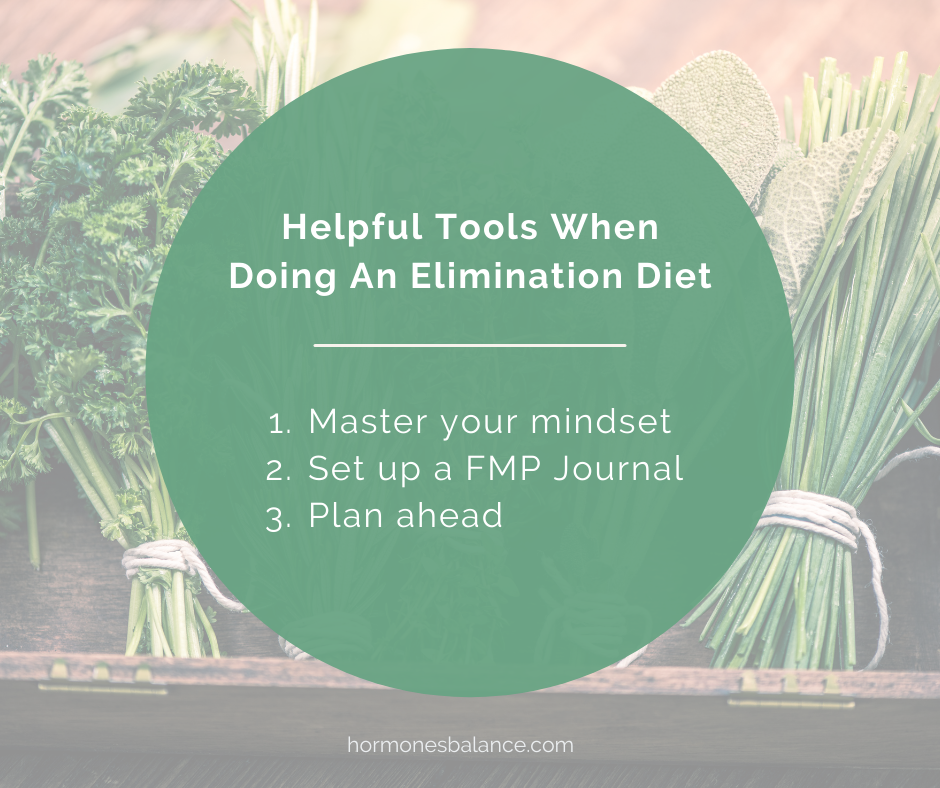
Master Your Mindset
Many people get anxious at the idea of doing an elimination diet because it seems too restrictive or limiting.
Here are a couple of things to tell yourself as you begin:
- This is only a temporary diet — After a few weeks, you’re able to go back to a wider range of foods afterward.
- It’s only a few foods that you’re temporarily eliminating — The majority of the foods in the supermarket or health food store you’re still going to be able to enjoy, including:
-
- Meats
- Fish
- Most vegetables (except nightshades)
- Healthy fats
- Many grains
- Herbs and spices (as long as they are not nightshades)
There’s still plenty to eat, especially when you consider the many different ways to prepare these foods and season with herbs and spices.
Set Up An FMP Journal
FMP Journal stands for “Food, Mood, and Poop Journal.” You may have seen these journals before in my books, Overcoming Estrogen Dominance and Cooking For Hormone Balance as well as my Estrogen Reset program.
An FMP Journal is a helpful tool for logging what you’re eating and how it makes you feel. It’s great because it helps us to connect with our bodies and see the responses, and it also helps us see our habits, like:
- Eating too much, too late at night
- Repeating the same foods over and over
- Eating too much sugar for breakfast
Here’s a look at a sample FMP Journal. Use this template to create one for yourself.
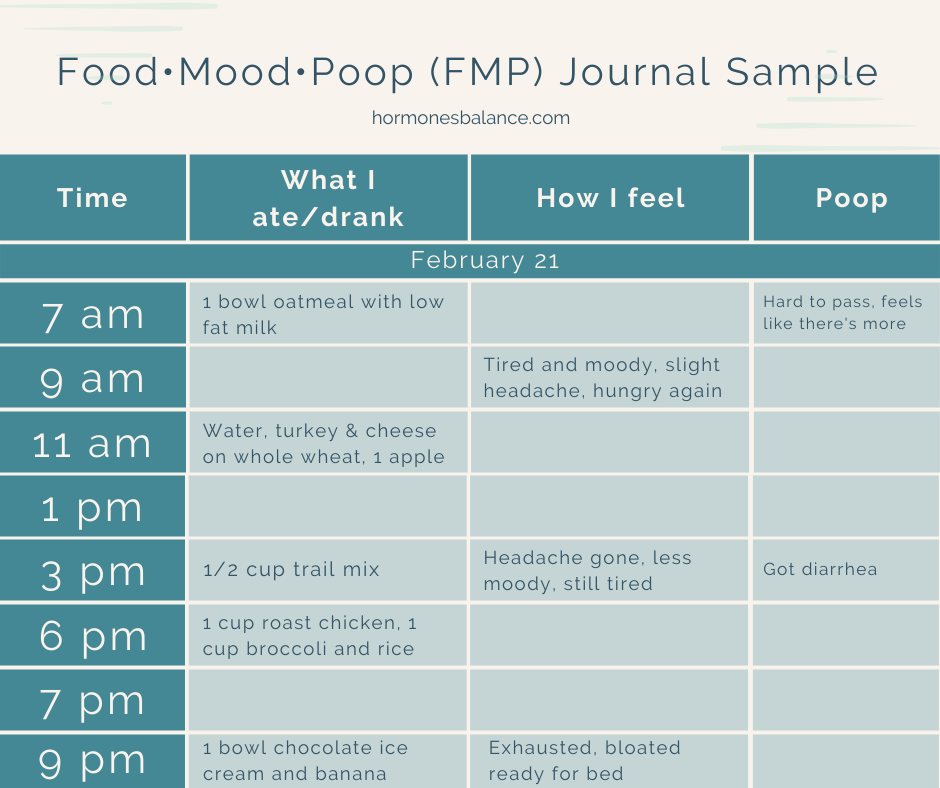
Without doing an elimination diet, you may not have ever noticed these trends.
Planning Ahead
Another tool that is really important for success with an elimination diet is simply planning ahead. This can involve a couple of strategies:
- Selecting recipes that are compliant with the elimination diet
- Making a meal plan for yourself that covers 1-2 weeks
Some resources for this include my books:
You can also find numerous recipes on the Hormones Balance blog. You can select them by food category or condition here.
Or browse all the recipes in list form here.
After The Elimination Diet: How to Reintroduce Foods
After completing 28 days on the elimination diet, you’re going to reintroduce the foods that were temporarily removed. While my books give a lot more detail on how to do this, you’re going to want to introduce a new food every 3 days and watch for reactions.
Here’s an example using eggs:
- Day 1 Introduce eggs.
- Day 2 If no reaction, eat eggs again and see how you feel.
- Day 3 Keep this food in your diet.
- Day 4 Try adding back a new food, like dairy.
When reintroducing foods, the reactions/symptoms to watch for include:
- Mood changes
- Changes in sleep quality
- Skin changes (such as dryness, pimples, eczema, rash, hives)
- Body aches and pains
- Stool changes (constipation, loose stool, diarrhea, gas, bloating, acid reflux)
All these things can indicate you’re having a reaction to a food.
Note: Just like mentioned earlier about the elimination diet, don’t reintroduce foods while traveling or away from your normal routine.
Also, don’t reintroduce food when expecting or on your period, because you won’t be able to tell if the bloating or mood changes are due to food or due to being on your period.
When you add the next food group, like dairy, try splitting it up; begin with a type of dairy that is better tolerated, like goat milk or sheep milk before progressing to cow’s milk dairy.
Generally, the idea is that you take time to introduce foods so that you can see specifically which foods are bothering you.
FAQ: Why Start With Food?
You might be wondering why I recommend using an elimination diet as a starting point for balancing hormones. Many practitioners start with supplements.
Here’s the thing: food is the number one item that goes into our bodies each and every day. Of course, it’s going to affect you: positively or negatively. Food is biochemistry and everything we’re consuming can either work for or against us.
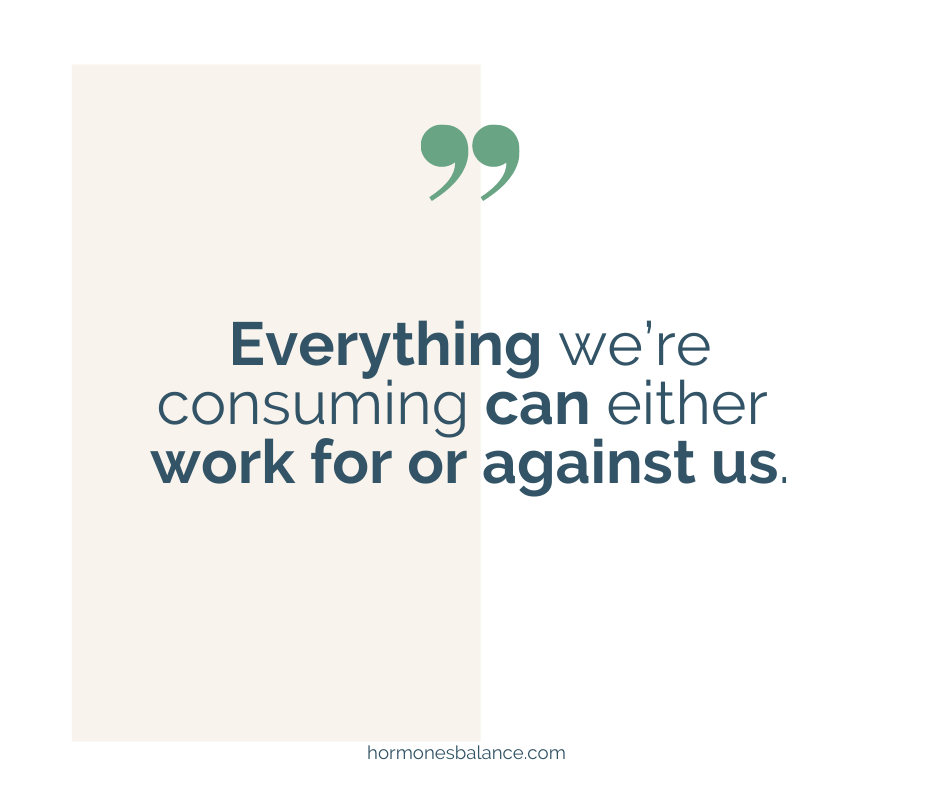
While supplements can be very supportive, and I totally believe in them (we created Wellena – our own supplement line), it’s important not to jump straight to supplementation. Supplements can be undermined by a diet that is causing inflammation — even from generally healthy food.
Sometimes supplements may even cover up a food sensitivity that needs to be addressed.
Why so many practitioners begin with supplements
- It’s easier for patients
- It can be more profitable for the practitioner
But doing so can result in not getting sustainable long-term results because you’re continuing to eat foods you’re sensitive to without giving the body a chance to heal.
Why Not Just Do An Allergy Test Like IgG?
Why not just do a food allergy test, rather than going through this whole, month-long process? There are a few reasons for this:
- They are unreliable. There are a lot of false negatives — meaning that a test could show that you have no problem with gluten, but that’s not actually true.
- If you haven’t been eating a particular food for a while, it will likely not show up in the test — That’s because you’re not producing antibodies for it. If you haven’t eaten eggplant or artichokes for a while, your immune system is likely not going to show a reaction to them.
The elimination diet is preferred by most functional practitioners because your body will never lie when reintroducing a food.
In my own practice, I’ve noticed IgG testing coming back with a lot of false negatives, creating the illusion that a lot of foods are not a problem when they actually are.
What’s Next? Life After Reintroduction
After doing the elimination diet and reintroducing foods, a lot of people notice an immediate improvement of the symptoms listed above, leading to things like:
- Balanced hormones
- Weight loss
- Better energy
- Improved digestion
- Less pain
- Clearer skin
- Fewer allergies
- Better breathing
- Deeper sleep
- Sharper thinking
- Improved immune system
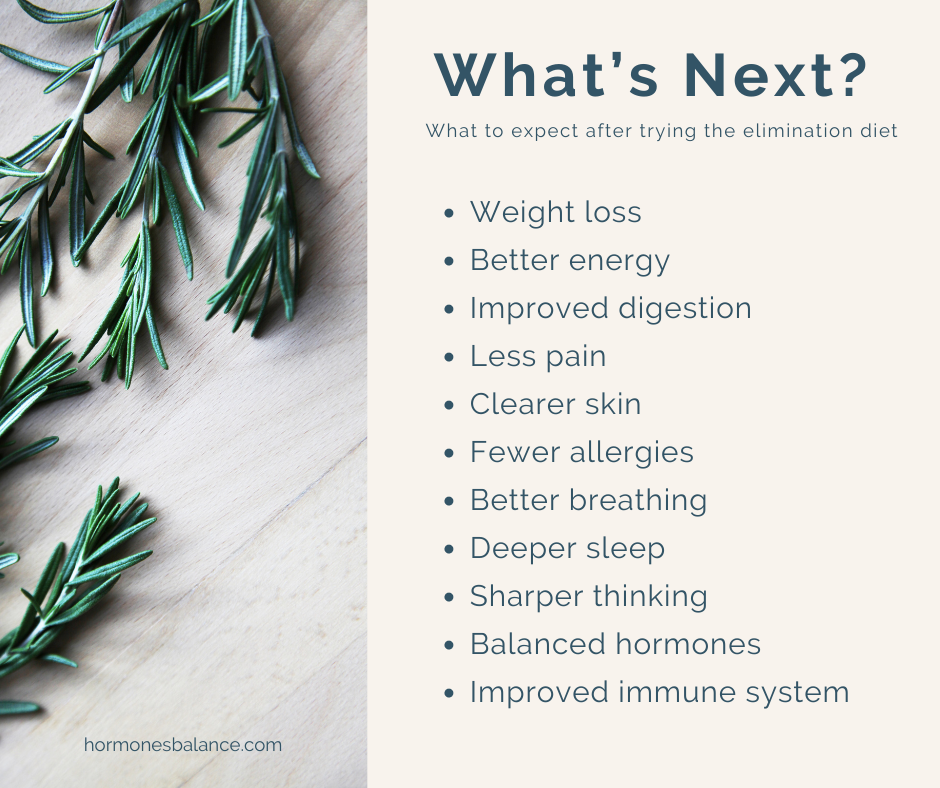
Although we recommend, for good hormonal health, to avoid gluten and dairy in the long term (i.e. forever, sorry!), the chances are that you will be able to eat many of the things you removed during the elimination diet such as eggs, corn, or nightshade vegetables.
If the elimination diet technique isn’t enough, you may need to go deeper into longer-term, more restrictive diets. That may involve following a diet like:
- The autoimmune paleo diet (AIP)
- A low FODMAP diet
- A low histamine diet
- A low oxalate diet
- A low salicylate diet
- A low sulfur (thiol) diet
…or a combination of these.
In Cooking For Hormone Balance, I explain how to select the next therapeutic diet based on your symptoms. Otherwise, I recommend working with a functional nutritionist to identify the next course of action for helping you to heal.
If you’re still experiencing digestive and other health issues, I recommend working with a functional medicine practitioner who may help “peel the onion” and go deeper with parasite testing as well as testing for other infections like SIBO, H. pylori, yeast, or parasites – they often are the reason for chronic GI issues.
From there, they can recommend more targeted treatments that may be required in addition to the elimination diet.
Conclusion and Where I am Today
While the elimination diet is a highly therapeutic diet, it’s meant to be done temporarily to help you detoxify gently, lower inflammation, and help you heal — not a lifelong restricted diet.
It’s used as a “detective’s tool” that will ultimately give you a lot of empowerment around food.
I personally have been staying on a modified version of the elimination diet for the past 15 years, yet completely enjoying food and eating, and never feeling deprived. The elimination diet has helped me heal my gut to such a great extent that a lot of my food sensitivities are significantly reduced. For example,
- Gluten: I can occasionally have gluten and not react to it
- Dairy: The same thing goes for dairy, but if I have too much I could get constipated
- Eggs: They are okay, but only about 2 times a week (otherwise, they make me tired)
I have also realized that my food sensitivities have changed over time. I am much less sensitive to gluten, dairy, and eggs, but I now have issues with onions and garlic. They are now causing severe bloating and gas, which I’m now addressing. It’s all a journey.
The elimination diet is one of the most powerful tools in your toolbox — It’s a huge “needle mover” for a lot of people. The key is to be prepared before you start, and we have a lot of resources to help you with that.
Are you thinking of trying an elimination diet? Let us know in the comments below.
Learn more with Overcoming Estrogen Dominance

“The body has an amazing ability to heal. We just need to give it the right resources.”
In Overcoming Estrogen Dominance, my goal is to empower and give you the tools to take control of your hormones and health.
More than 70% of women experience estrogen dominance. The symptoms range from lumpy and fibrocystic breasts to thyroid nodules, hot flashes, fibroids, uterine polyps, painful, heavy or irregular periods to infertility and miscarriages, from mood swings to insomnia, weight gain to fatigue.
So many women have experienced the pain and frustration that comes when they feel their symptoms and complaints are dismissed or minimized. This is particularly true for women who are experiencing the symptoms of hormone imbalance. Even when doctors do offer treatment, it’s typically in the form of prescription medication or invasive surgical procedures.
In Overcoming Estrogen Dominance, I hope to show that those extreme interventions are often unnecessary, and to give women a roadmap to reverse estrogen dominance using food, herbs, supplements and natural protocols to rebalance hormones.
To get your copy of Overcoming Estrogen Dominance, go here.
Resources
- Atkinson, W et al. “Food elimination based on IgG antibodies in irritable bowel syndrome: a randomised controlled trial.” Gut. 2004.
- Hindiyeh, Nada Ahmad et al. “The Role of Diet and Nutrition in Migraine Triggers and Treatment: A Systematic Literature Review.” Headache. 2020.
- Katta, Rajani, and Mary Jo Kramer. “Skin and Diet: An Update on the Role of Dietary Change as a Treatment Strategy for Skin Disease.” Skin therapy letter. 2018.
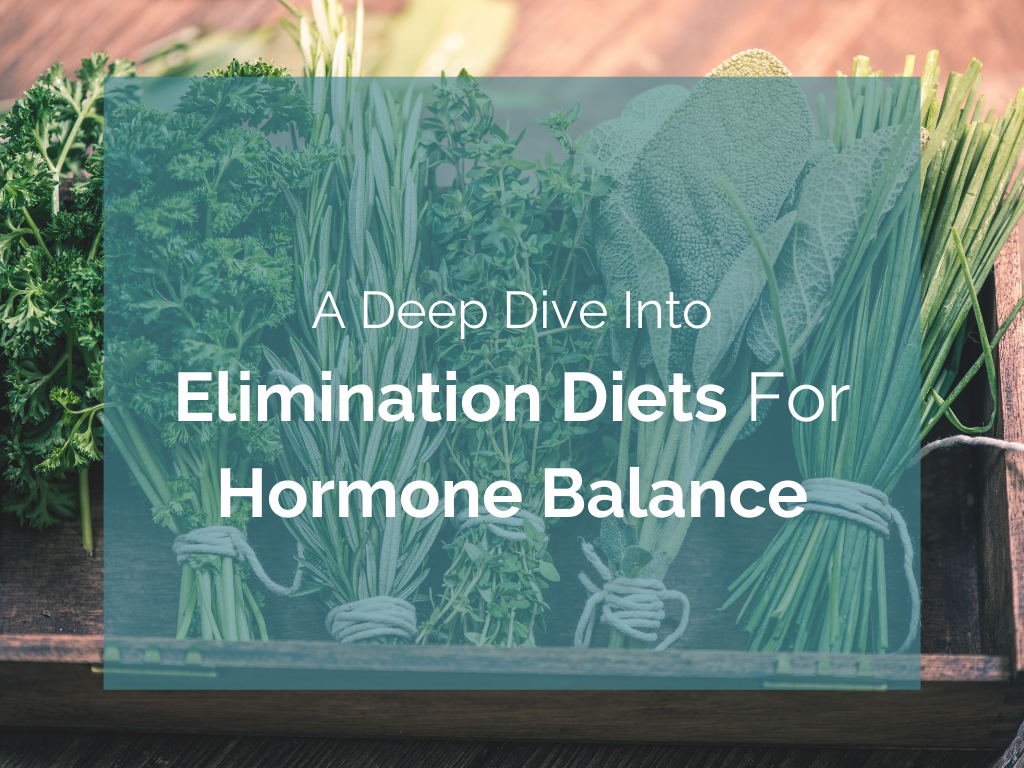
Hi- I realy would like a diet that could help my with my hormones. Im tired all the time- sleeps very instabil, have brainfog which really is anoying..dont have any sexhunger, and I could sleep for ever.. avoyding wheat, milk. Drink a kor of coffee, which is not the best think for my stress. I feel overloaded when there are changes in my life- normally I love challenges🤷♀️. Can you please help me with a diet – i still have my period – age 51 ..
Thankx🙏
Hi Berit, Magdalena include an anti-inflammatory meal plan in her most recent book, Overcoming Estrogen Dominance. This can a great place to start to create a foundation for rebalancing your hormones. The book also includes a wealth of information on lifestyle changes, herbs and supplements that can also help. Here is the link: https://overcomingestrogendominance.com/
Please send us an email at [email protected] if you would like more resources. We’re happy to help in anyway we can. ~HB Support
What about raw milk? Are there any differences noticed between this pure product and the milk sold in grocery stores?
Hi Lisa, there are many differences between raw milk and the milk you would find in a typical grocery store. The most notable difference would be the preservatives and additives included in the grocery store brands. That said, not everyone has the enzymes needed to break down raw milk or grocery store brands of milk. We would encourage you to go through an elimination plan to explore whether raw milk could be an option for you or not. ~HB Support.
Good morning. I recently bought “Cooking for hormone balance ” in order to find a solution to my many simptoms menaupose and hypothyroid. But I have a question regarding the use of avocado. Here in France they are expensive and imported from Mexico for the most part and they are grown with a lot of pesticids. Are their some other food I could use to replace avocado.
Thank you very luch for your help
Catherine
Hi Catherine, we encourage you to make substitutions as needed to fit your needs! Edamame, low-glycemic fruit, hummus, or nut butters could also be replacement options. ~HB Support
I just bought the new book and I ordered the Fibroid Kit. I have mild SIBO and I am wondering if the Brocco Power could flare it. Have you had feedback from clients that have experienced this with this supplement or any of the Estrogen reducing supplements?
Or is it a small enough of an amount that is shouldn’t pose a problem?
Thanks!
Hi Nicky, the Brocco Power should not flare it as the sulforaphane contained affects the GI differently than raw cruciferous vegetables and can actually be helpful in dealing with SIBO and any kind of leaky gut issues. ~HB Support